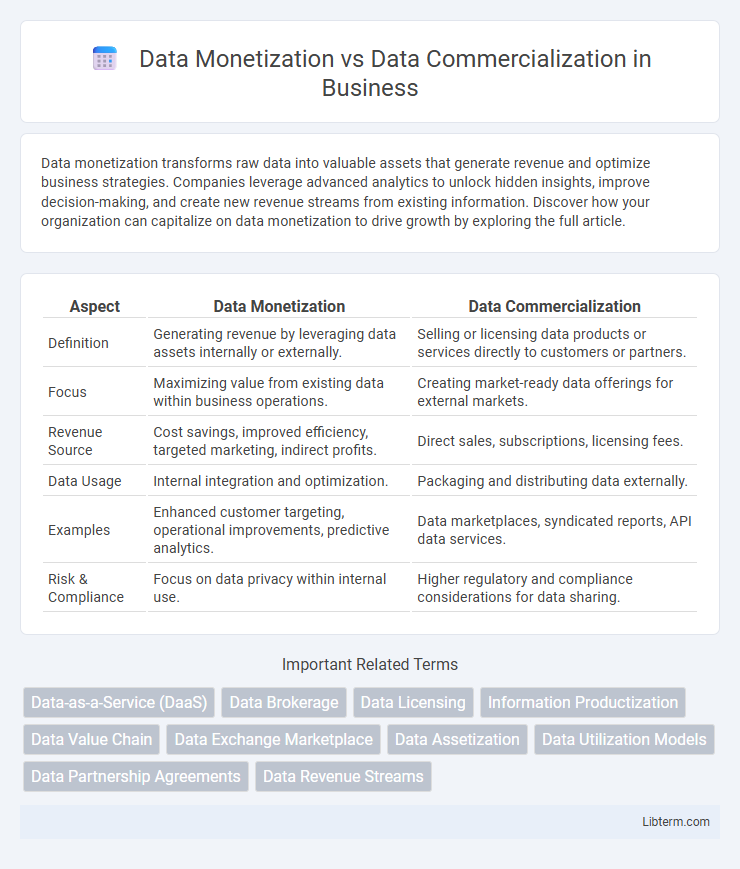Data monetization transforms raw data into valuable assets that generate revenue and optimize business strategies. Companies leverage advanced analytics to unlock hidden insights, improve decision-making, and create new revenue streams from existing information. Discover how your organization can capitalize on data monetization to drive growth by exploring the full article.
Table of Comparison
| Aspect | Data Monetization | Data Commercialization |
|---|---|---|
| Definition | Generating revenue by leveraging data assets internally or externally. | Selling or licensing data products or services directly to customers or partners. |
| Focus | Maximizing value from existing data within business operations. | Creating market-ready data offerings for external markets. |
| Revenue Source | Cost savings, improved efficiency, targeted marketing, indirect profits. | Direct sales, subscriptions, licensing fees. |
| Data Usage | Internal integration and optimization. | Packaging and distributing data externally. |
| Examples | Enhanced customer targeting, operational improvements, predictive analytics. | Data marketplaces, syndicated reports, API data services. |
| Risk & Compliance | Focus on data privacy within internal use. | Higher regulatory and compliance considerations for data sharing. |
Introduction to Data Monetization and Data Commercialization
Data monetization refers to the process of generating measurable economic benefits from data assets by leveraging analytics, insights, and operational improvements. Data commercialization involves packaging and selling data products or services to external customers, often through platforms or data marketplaces. Understanding the distinction helps organizations decide whether to use data internally to boost efficiency or externally to drive revenue growth.
Defining Data Monetization
Data monetization refers to the process of generating measurable economic value from data assets, often through direct sales, licensing, or monetizing insights to improve business operations. It involves leveraging data to create new revenue streams or optimize existing ones by analyzing customer behavior, enhancing product offerings, or improving decision-making. Unlike data commercialization, which broadly includes all activities aimed at bringing data-related products or services to market, data monetization specifically emphasizes transforming data insights into quantifiable financial gains.
Defining Data Commercialization
Data commercialization involves transforming raw data into marketable products or services that generate revenue streams through direct sales, subscriptions, or licensing agreements. This process includes data cleaning, enrichment, packaging, and ensuring compliance with privacy regulations to maximize the data's economic value. Unlike data monetization, which may include internal cost savings or operational efficiencies, data commercialization specifically targets external market opportunities by offering data as a strategic business asset.
Key Differences Between Data Monetization and Data Commercialization
Data monetization involves converting raw data into revenue through direct sales, subscriptions, or usage fees, emphasizing financial gain from existing data assets. Data commercialization focuses on creating new products or services derived from data, integrating data insights into market offerings to enhance value and customer experience. The key difference lies in monetization targeting immediate revenue from data itself, while commercialization leverages data to innovate and expand business opportunities.
Common Strategies for Data Monetization
Common strategies for data monetization include direct data sales, where organizations sell raw or processed data to third parties, and data-as-a-service models that provide subscription-based access to data platforms. Another approach involves embedding data insights into products or services to enhance value, such as personalized recommendations or predictive analytics. Companies also leverage data partnerships and licensing agreements to extend reach and generate recurring revenue streams.
Popular Approaches for Data Commercialization
Popular approaches for data commercialization include licensing data to third parties, creating data-as-a-service (DaaS) platforms, and embedding data insights into products or services. Companies often leverage APIs to provide real-time data access and subscription models to generate recurring revenue streams. These strategies enable organizations to transform data assets into tangible financial gains while maintaining data control and compliance.
Benefits and Risks of Data Monetization
Data monetization unlocks revenue streams by leveraging internal and external data assets through direct sales, licensing, or enhanced services, improving business agility and competitive advantage. Benefits include increased profitability, optimized decision-making, and fostering innovation, while risks encompass data privacy breaches, regulatory compliance challenges, and potential loss of data control. Unlike data commercialization, which primarily involves packaging data products for external markets, data monetization emphasizes strategic internal use and value extraction from broader data ecosystems.
Advantages and Challenges of Data Commercialization
Data commercialization offers significant advantages such as unlocking new revenue streams by transforming raw data into valuable products or services, enhancing competitive advantage through data-driven insights, and fostering innovation via partnerships and data sharing. Challenges include ensuring robust data privacy and security measures to comply with regulations like GDPR and CCPA, managing data quality and integration from diverse sources, and addressing ethical concerns related to data ownership and consent. Successful data commercialization requires balancing these factors to maximize value while minimizing risks associated with data misuse and regulatory penalties.
Real-World Examples: Data Monetization vs Data Commercialization
Data monetization involves leveraging proprietary data to generate direct revenue streams, as seen with companies like Uber using ride data analytics to optimize pricing and boost profits. Data commercialization extends beyond direct sales, encompassing the creation of new products or services based on data insights, exemplified by Fitbit licensing user health data to insurance companies to develop personalized wellness programs. These real-world examples highlight the strategic differences: data monetization focuses on immediate financial returns from data assets, while data commercialization builds broader market value through innovative data-driven offerings.
Future Trends in Data Monetization and Commercialization
Future trends in data monetization emphasize leveraging artificial intelligence and machine learning to unlock deeper insights and create personalized products, driving higher revenue streams. Data commercialization is expected to expand through ecosystem partnerships and data marketplaces, enabling secure data sharing and collaborative innovation across industries. Advances in blockchain technology will enhance transparency and trust, facilitating greater adoption of data-driven business models globally.
Data Monetization Infographic

 libterm.com
libterm.com